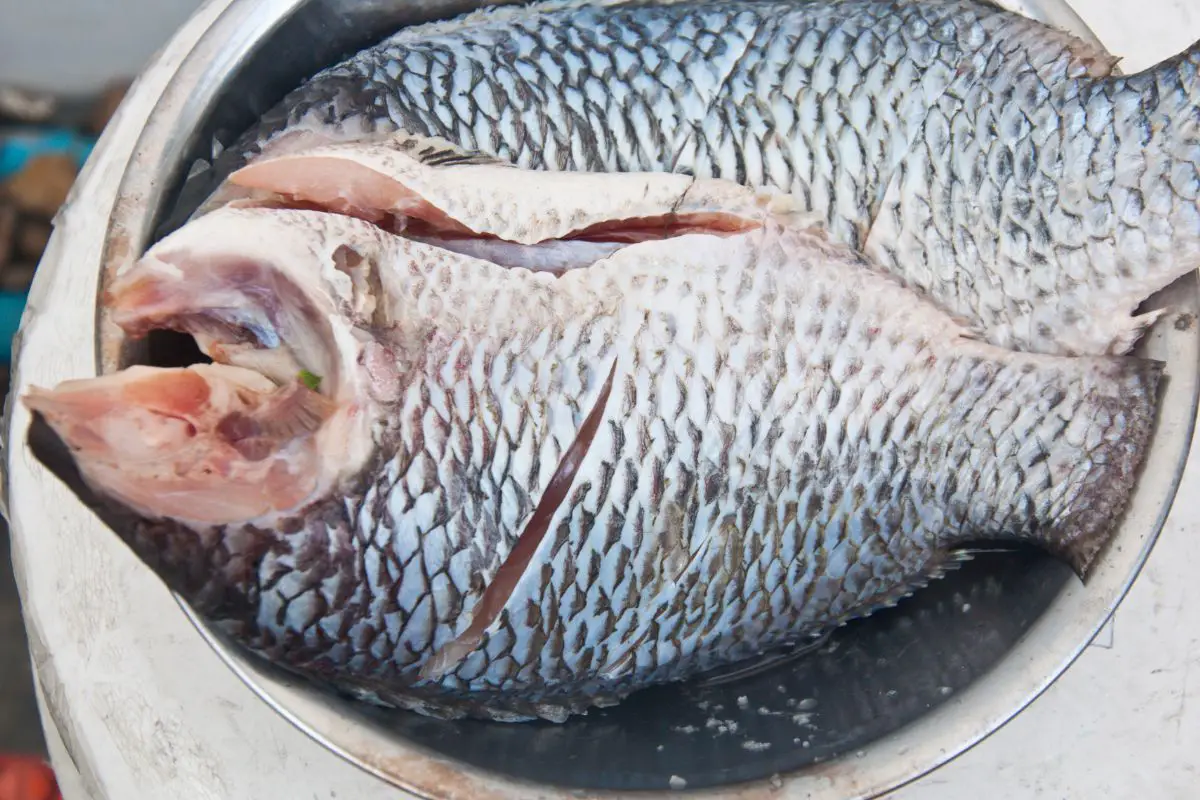For a quick answer, yes, you can include tilapia into your dog’s diet without too many issues and in most cases we think it is a good food for them to have since it has plenty of useful proteins as well as good fats as well a barely any carbohydrates.

In just one 3 ounce fillet of tilapia you will get over 20 grams of protein and over 2 grams of fat.
As most dog owners know, making sure you give them a good amount of protein is important for their nutrition and will ensure that they build their muscles.
For a puppy, they will need 28% of protein in their daily diet, while for an adult dog 18% will be sufficient.
By just adding a single medium sized tilapia fillet of around 6 ounces, your dog will be able to easily surpass their protein requirements.
The protein content is not the only positive aspect of Tilapia though, it also contains plenty of useful nutrients including good fatty acids with the best one being Omega 3.
Omega 3 is known for its anti-inflammatory qualities and is great for dogs since it will keep their brain, heart, fur, joints, and skin, in the best shape it can.
If your dog gets a full serving of tilapia they will also get some great minerals and vitamins too, these include; folate, phosphorus, potassium and vitamin D.
By getting these vitamins your dog will have a healthier and longer life.
So, while there are plenty of positive aspects to feeding your dog tilapia, there are some things which you should keep in mind!
Tilapia Is Good For Them But Keep Some Things In Mind
So, as we mentioned, it is known that tilapia is great for dogs, however, your dog should not be eating tilapia or any seafood for that matter, too often (see also ‘Can Dogs Eat Deer Bones?‘).
This is because, while tilapia has plenty of great nutrients, it also contains selenium, niacin, and vitamin b12.
These elements are worth noting because when they are in trace amounts they are very helpful in aiding your dog’s metabolism.
For example, niacin, will help your dog in breaking down fatty acids, but if they get too much niacin, it will not be helpful and will lead to liver problems and diarrhea.
This is similar with selenium and vitamin b12 as they are great for helping with digestion (see also ‘How Much Pumpkin Should A Dog Have For Constipation?‘), but if you give them too much, they will face some potentially severe gastrointestinal issues.
Can Your Dog Eat Raw Tilapia?
One thing which should be noted is that you should avoid letting your dog eat tilapia which is raw, as well as other different types of raw fish.
If you do let your dogs eat raw fish, this can lead to some quite impactful issues which you will want to avoid and could even have your dog end up at the vets.
If you are an experienced dog owner you likely know that the way a dog’s stomach works is different from ours and even though they can digest quite a lot of things due to having a strong stomach acid, it does not mean that they should.
If a fish is raw and unprepared, they can contain parasites and microorganisms which will be quite harmful to your dogs.
This is even more so when considering puppies since they have an even more delicate stomach than a fully grown dog.
There are also tiny bones in fish which could potentially splinter within the throat of your dog or in their gastrointestinal tract, this could lead to them getting micro-perferations in these parts of their bodies which can be incredibly painful for the dog and will not be something which is simple or easy to fix.
If you have accidentally let your dog eat raw fish, or if your dog has stolen a piece of raw fish and managed to swallow it, there are certain symptoms you should look out for, and if you see them, you and your dog should visit a vet. These include:
- A noticeable lack of appetite
- Vomiting
- Scooting
- Diarrhea
- A distended abdomen
- A dull coat
- Itching
- Bald spots
- Noticeable weight loss
- A fever
It is often very difficult to notice if a parasite is present in a fish, but if your dog has consumed them, you should be able to recognize them with a blood test.
It is also worth noting that you are much more likely to find parasites in fish which are caught in the wild as opposed to fish raised in a farm.
Some of the more dangerous parasites which your dog could pick up from eating a raw fish would be; roundworms, flukes, or tapeworms.
But, you should not have to worry about these if you are not letting your dog eat raw fish. It is well known that parasites like these will die in a low temperature, so you do not have to worry about them getting anything from sushi, even if they should still probable avoid this.

Can Your Dog Eat Cooked Tilapia?
It is perfectly fine for a dog to eat tilapia which has been cooked. There are plenty of different ways to cook tilapia to make it a good snack for a dog (see also ‘Are Welch’s Fruit Snacks Safe For Dogs?‘) whether this is by steaming it, or by putting it in a dehydrator.
Dehydration is one of the most practical methods as this will make it easy to travel with for a snack on the go.
As we mentioned earlier on, we still recommend not giving your dog fish too often as this can lead to digestive and gastrointestinal issues. It can also lead to itching and bald spots as well.
One of the best ways to keep your dog healthy is to ensure that they have a balanced diet as this will keep them in good shape.
So, including cooked fish like tilapia is going to be beneficial every now and then, however, including too much fish will lead to issues which you likely want to avoid.
We should also mention that if you are feeding your dog a standard commercial dog food and give them vitamins, they have very little need for extra supplements and table food to give them a good diet.
So, if you want to feed your dog fish, ensure that this does not go over 10% of their daily intake.
Can Your Dog Eat Fried Tilapia?
If there is one thing your dog will certainly want to eat, it is a delicious fried tilapia, however, we would recommend that you avoid feeding this to your dog.
This is because the process of frying a fish like tilapia adds a lot of fat and oil which will not be beneficial for the health of your dog.
When tilapia is fried, rich flavorings and plenty of salt is usually added, and none of this will agree with your dog’s digestive system and will likely shock the system leading to further issues.
The issue with feeding your dog fried tilapia is that you will likely not notice any issues after just 1 or 2 feedings, but it will still be contributing to issues which you want to avoid.
If you begin to start feeding your dog fried tilapia regularly, they will start to accumulate oil and sodium and this will start to contribute to gut problems.
This could also lead to other issues like diarrhea and loose stools which can make life very uncomfortable for your dog. These are similar symptoms to when a dog is fed onions and garlic too frequently.
This is why vets tend to recommend that instead of feeding your dog food which is intended for humans like fried tilapia, we instead give them good quality food designed for dogs and kibbles.
How To I Cook Tilapia For A Dog?
If you regularly enjoy tilapia yourself, you know that it is a satisfying dish for people however it is cooked and will usually be tasty.
Since dogs have a heightened sense of smell and taste, they will likely like the taste of cooked tilapia as well.
When cooking tilapia, you will want to ensure that the skin of the fish has been removed to ensure it is not a choking hazard, and that it gets completely deboned, so there are no splinters in your dog’s system.
If you are cooking tilapia specifically for a dog, we recommend that you mash or process your tilapia so there are no bones or fragments in there.
If you want to know some nice ways to cook tilapia for your dog, we have a couple of examples on how to do that here!
Tilapia With Tomatoes And Carrots
For this recipe you need 2 medium sized tilapia with some canned tomato and a medium sized carrot. After you have cleaned your tilapia cut them in half.
After this you should mince your tomatoes and carrots into small pieces. Once this is done we recommend simmering everything in your pan until the tilapia is cooked through.
You can serve this by adding it to your usual dog food or kibble.
Baked Tilapia And Sweet Potatoes
This recipe simply needs 1 tilapia and a cup of sweet potatoes. After cleaning your tilapia, wrap it up in foil and then bake it for 5 minutes on each side at 145 degrees Fahrenheit.
After this you want to let the fish cool down and then take the bones out carefully and then cut the fish into small pieces.
While the tilapia is baking you can boil your potatoes until they are tender and then cut them into smaller pieces as well. Then combine the two and add to your dog food when you are ready to serve.

Frequently Asked Questions
Why Is Tilapia Bad For Your Dog?
Tilapia is not a type of fish which will be inherently dangerous for your dog.
As we have mentioned, it contains plenty of useful nutrients which will be beneficial for your dog, it should just not be enjoyed by your dog too frequently as some of the elements it contains can ruin their digestive system if they are eaten in excess.
The nutrients which are provided by tilapia range from; folate, phosphorus, potassium, and even vitamin D which are all very useful for your dog.
It is also well known that tilapia contains a lot of proteins which is an essential part of any dog’s diet and should be fed to them regularly.
It is worth reinforcing that you should ensure that when you are feeding your dog tilapia, you are never feeding it to them raw and that it is always cooked.
This is because a lot of fish which is uncooked, especially if you have caught it yourself, can contain parasites which can be harmful and even deadly to some dogs.
So, make sure to remember that while your dog can enjoy seafood like tilapia, every now and then, and that it will be nutritious when they have it, you should not make it a staple in their diet which they eat too regularly.
It is also worth pointing out that the mercury levels in tilapia can also be quite dangerous if eaten too often, this is why we strongly recommend keeping this fish as an occasional treat.
What Kinds Of Fish Are Safe For Your Dog?
It is actually lucky that there are many different types of fish which are appropriate for a dog to eat and will make a good part of your dog’s diet.
Tilapia is one of these because of all the protein it contains as well as the healthy nutrients.
But, tilapia is not the only fish which has the benefits of providing your dog with nutrients like; omega 3, protein, fatty acids, minerals, and vitamins, and that other fish can be considered too. For example your dog can eat:
- Cod
- Whitefish
- Tuna
- Whiting or Hank
- Flounder
- Salmon
- Herrings
- Catfish
Just to name a few appropriate choices to choose from. If you are worried about feeding your dog a specific type of fish, just check on a search engine and it is likely that you will soon find the answer.
However, it is worth pointing out that when it comes to feeding your dogs fish you should only feed it to them as a treat they get occasionally, and not something which they are regularly going to eat.
When you are cooking this fish in a way which is appropriate for dogs, it will likely not be appetizing for humans. For example, you will need to keep it clear of any salt and pepper, as well as excess fats like oil, and most seasonings.
So while if it is cooked correctly, it can be a nice occasional snack for them, do not do this too regularly.
Summary
So, tilapia is a delicious and economic choice of fish for people to enjoy, and if you prepare it correctly, it can also be enjoyed by dogs as well.
It will provide them with plenty of protein and nutrients. You just want to make sure that you do not cook it for them regularly and instead save it for a treat every now and then.
- Are Antlers Safe For Dogs? - January 14, 2024
- Can Dogs Eat Honey Nut Cheerios? - December 23, 2023
- Natural Deworming Remedies for Your Dog - December 18, 2023









